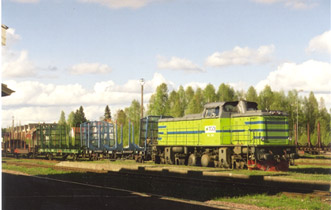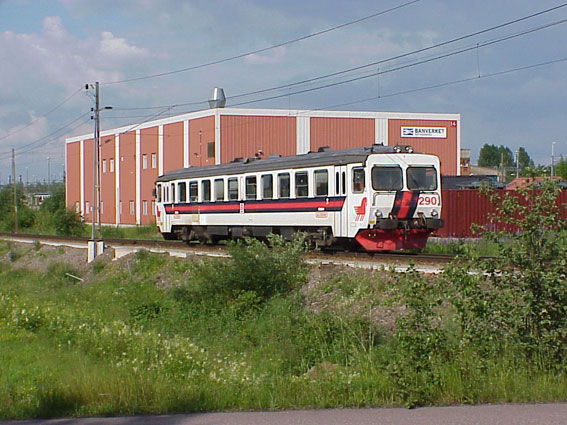
A TGOJ T43 resting for the weekend in Orsa, August 2001. See more in Ollies trainstuff!, all colorphotos by Ollie Ahokas

Y1 1290 is slowing down, just a couple kilometers to go to Borlänge
Y1/YF1, the current passangertrains
Short background
During the seventies the Y6-8 generation was about to be in their finale legs and needed replacements. The railcars ran on secondary and branch lines that were uneconomical and State Railways wanted abandonment on these lines. The Parliament backed by local interests along the lines wanted contrary. It as considered uneconomical to design the new a new generation of railcars and studies were made on designs in Europe. Two one Italian and a newly produced German caught the eye and during April - June 1975 trials were carried out to see how they could be operated during the cold winter and in snow. But by the time the railcars finally arrived, it was already spring. And during January - February the cars were tested during the coldest winter period. During the tested the Italian ALn-668, which was an older design than the VT 627, which was to be a prototype for DB.s VT628 faired better and the future class would be based on the Italian railcar.The 16.th of June 1977 SJ placed an order of 100 rail cars from FIAT. The were a number of alternations, the maximum speed was increased from 120 km/h to 130 km/h the railcar would receive conventional buffers and couplers, and the passenger area was completely changed, The doors were placed to the ends behind the cabs, to enable the train for crew of just one person and the interior was only second class and placed like seating in a bus. The car could carry 76 passengers.
The deliveries were delayed by strikes in Italy and just before Christmas in 1979 the first cars was taken for passenger services. In the spring of 1980 SJ could make a study on the new cars performance, On positive side they had good comfort, ran nicely but the negative sides were overwhelming amongst them was lack of ventilation, wrong angle on back of the seats, with extreme cold the engine ventilation stuck and the door opening pushbuttons stuck and became unpalatable. And the performance on cold weather in all was dissatisfactory. The car could carry only a limited number of baggage and express freight and running old adopted two-axle baggage cars pushed the limit of the underpowered cars. The last of the cars, which were not yet produced were to be produced as combines.
The problems were so severe that FIAT sent 25 technicians to Mora to solve the problems and the cars delivered from 1981 received two different ventilation systems and the number of open able windows was doubled. After a number of rebuilds a number of cars were transferred to various operators, who in some cases modified the car even further. Many of these cars are now repainted in the new owners colors. At least on has been rebuilt as a rail inspection car and a pair has sold to Norway, where they run on by a regional operator in southwest.
Today the cars needs replacement and the offerings of modern railcars has exploded by different builders, it will interesting to see what the future will bring.